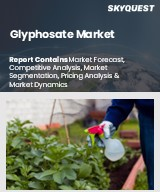
|
시장보고서
상품코드
1457000
세계의 글리포세이트 시장 예측(2024-2029년)Glyphosate Market - Forecasts from 2024 to 2029 |
||||||
글리포세이트 시장은 2022년에 102억 2,300만 달러로 평가되었고 복합 연간 성장률(CAGR) 5.12%로 성장할 전망이며 2029년에는 145억 100만 달러 규모에 이를 것으로 예측됩니다
글리포세이트는 곰팡이와 포자병으로부터 자신을 보호하고 방제하는 농약입니다. 글리포세이트는 특정 진균병뿐만 아니라 여러 원인에 의한 진균병도 방제할 수 있습니다. 진균병에 대한 감수성이 높기 때문에 과일 및 채소의 재배가 글리포세이트 수요를 세계적으로 밀어 올리고 있습니다. 현대적인 농법, 작물을 공격하는 곰팡이의 발생률 상승, 다른 방제 방법보다 살균제의 비용이 낮다는 것이 글리포세이트 수요를 밀어 올리고 있습니다. 살균제 제조업체는 정밀 농업 및 유기 농업 동향으로부터 혜택을 누릴 것으로 예상됩니다. 시장 성장에는 고수율에 대한 수요 증가, 세계 인구 증가, 신흥 시장에서 고가치 작물에 대한 수요 증가 등 여러 요인이 영향을 받고 있습니다. 세계 인구 증가율은 현재 약 1.05%를 나타낼 전망입니다. 매년 평균 8,100만 명의 인구 증가가 예상됩니다. 인구는 2037년까지 90억 명에 달했으며, 향후 40년간 더 50% 증가할 것으로 추정됩니다. 세계 식품 수요 증가는 이러한 추세에 반영됩니다. 2050년까지 식량 수요는 59-98% 증가할 것으로 예상됩니다.(출처: fao.org, WHO). 이 수요를 충족시키기 위해, 글리포세이트와 같은 제초제는 작물과 식물의 성장에 해로운 잡초를 죽이는 데 사용될 수 있으므로 수요가 증가합니다.
글리포세이트의 범용성과 유연성은 야채 생산자에게 전달되는 주요 이점으로 꼽힙니다. 글리포세이트를 사용하는 야채는 거의 모든 장소에서 거의 모든 기후에서 사용할 수 있습니다. 글리포세이트의 살포는 밭작물에서는 생육기의 후반에 행해지는 것이 많아, 그 에이커수로부터 봐도 대부분을 차지하고 있습니다. 북미와 아시아태평양에서 글리포세이트는 유리한 제품입니다. 아시아태평양의 글리포세이트 시장은 GM 작물의 도입과 경작 가능한 토지 확보가 향후 시장을 견인할 것으로 예상됩니다.
시장 성장 촉진요인:
- GE-HT 작물의 상업화
다양한 제초제 내성(HT) 작물은 농업 종사자에게 잡초 방제의 광범위한 옵션을 제공합니다. 보다 높은 수율과 품질을 가진 작물에 대한 수요 증가, 경작에 의한 농지의 손실, 잡초 손실의 감소의 결과, 글리포세이트 수요는 향후 증가할 가능성이 있다고 합니다. 현재 미국에서 재배되고 있는 옥수수, 육벼면화, 대두의 90% 이상이 유전자 재조합 품종에 의해 생산되고 있습니다. 이 데이터 제품에서 유전자 변형 작물은 제초제 내성(HT), 곤충 저항성(Bt) 또는 HT와 Bt 특성을 모두 포함하는 스택 품종으로 분류됩니다. 미국에서 생산되는 작물에서 가장 일반적인 GE 특성은 HT와 Bt이지만, 다른 특성(바이러스와 균류에 대한 내성, 가뭄에 대한 내성, 단백질, 유분, 비타민 함량 증가 등)도 개발되어 있습니다. 유전자 변형 작물의 제작 면적의 대부분은 옥수수, 면화, 콩의 세 가지 주요 밭작물에 심어져 있지만, 루츠르네, 카놀라, 사탕무의 생산에도 HT 종자가 사용되는 경우가 많습니다. 그 결과, 글리포세이트는 가동 가능하고 사용하기 쉽고 일반적으로 합리적인 가격이기 때문에 농업 현장에서 효과적인 제초제로 남아 있습니다.
- 제초제 내성 작물 하이브리드의 승인
제초제 내성 작물 하이브리드는 글리포세이트와 같은 비선택성 제초제를 견딜 수 있도록 유전자 재조합된 작물입니다. 글리포세이트에 대한 내성을 개발하기 위해, 많은 연구개발은 종에도 불구하고 모든 식물을 방제할 수 있는 가장 효과적인 제초제인 글리포세이트의 평가에 초점을 맞추었습니다. 여러 기업이 지속적으로 조사를 실시하여 제품을 시장에 발송하고 있습니다. 예를 들어, 바이엘 크롭 과학은 XtendFlex 대두를 2021년 캐나다에서 출시할 것이라고 발표했습니다. XtendFlex 대두 형질 기술은 디캄바, 글루포시네이트 내성을 제공하는 것으로, Roundup Ready Xtend 작물 시스템의 최신 추가입니다.
시장 성장 억제요인:
- 기준의 부족과 환경에 대한 영향
글리포세이트의 환경 영향은 육상 환경과 수생 환경 모두에서 몇 가지 보고되었습니다. 더 큰 규모에서 글리포세이트는 생태계 전체의 중요한 구성요소입니다. 제초제가 수역으로 유출되면 오타마작이나 물고기와 같은 수생생물이 사멸합니다. 글리포세이트가 살포된 지역의 식물을 시들뿐만 아니라 주변의 식물도 시들어집니다. 육상이든 수중이든, 이러한 생물의 죽음은 광범위하게 영향을 미칩니다. 이러한 환경에 미치는 영향은 시장 전반을 위협합니다.
북미 글리포세이트 시장은 크게 성장할 것으로 예상됩니다.
북미 글리포세이트 시장에 영향을 미치는 주요 요인은 농업, 특히 글리포세이트 처리에 내성을 갖는 유전자 변형 작물의 생산에 널리 응용되고 있다는 것입니다. 잡초를 효율적으로 관리하는 방법을 찾는 농업 종사자들은 글리포세이트가 광범위한 효능과 저렴한 가격으로 표준 제초제임을 알고 있습니다. 글리포세이트 수요는 지속 가능한 토양 관리를 목적으로 하는 보전 경작이나 불경기법을 채용하는 농업의 결과로 증가하고 있습니다. 또한, 이 제초제는 농업 환경뿐만 아니라 비농업 상황, 숲, 산업 지역에서도 사용됩니다. 시장의 중요성의 원인은 자생 환경에서 침입 식물 종의 억제 효과에 있습니다.
주요 발전:
- 2023년 3월Corteva Agriscience의 직접 판매 사업 글리포세이트가 Albaugh, LLC에 인수되었습니다. Corteva가 세계 스트레이트 굿 글리포세이트 사업에서 활용하고 있는 무형 자산(아르헨티나 제외) 중, 상호, 등록, 규제 정보, 제제, 특허만이 이번 인수에 포함됩니다.
- 2023년 2월, Corteva는 카놀라 생산자를 위한 최첨단 제초제 내성 형질전환 기술인 Optimum(R) GLY 카놀라의 상업적 도입 계획을 밝혔습니다. Corteva Agriscience의 개척자(R)와 브레반트(R) 씨앗 브랜드는 2023년 미국과 캐나다에서 상업 심기용 옵티맘 GLY 카놀라를 판매하기 시작했습니다.
목차
제1장 서론
- 시장 개요
- 시장의 정의
- 조사 범위
- 시장 세분화
- 통화
- 전제조건
- 기준년과 예측년의 타임라인
- 이해 관계자의 주요 이점
제2장 조사 방법
- 조사 디자인
- 조사 과정
제3장 주요 요약
- 주요 조사 결과
- CXO의 시점
제4장 시장 역학
- 시장 성장 촉진요인
- 시장 성장 억제요인
- Porter's Five Forces 분석
- 업계 밸류체인 분석
- 애널리스트 보기
제5장 글리포세이트 시장 : 용도별
- 소개
- 재래작물
- 유전자 변형 작물
제6장 글리포세이트 시장 :작물 유형별
- 소개
- 과일 및 채소
- 곡류 및 곡물
- 지방종자 및 콩류
제7장 글리포세이트 시장 : 지역별
- 소개
- 북미
- 남미
- 유럽
- 중동 및 아프리카
- 아시아태평양
제8장 경쟁 환경과 분석
- 주요 기업과 전략 분석
- 시장 점유율 분석
- 합병, 인수, 합의 및 콜라보레이션
- 경쟁 대시보드
제9장 기업 프로파일
- BASF SE
- Bayer AG
- Xingfa USA Corporation
- Solvay
- Nufarm
- SinoHarvest
- Albaugh LLC
The glyphosate market is evaluated at US$10.223 billion for the year 2022 growing at a CAGR of 5.12% reaching the market size of US$14.501 billion by the year 2029.
Glyphosates are pesticides that protect against and control fungi and spore diseases. Glyphosates can control specific fungal diseases as well as those from multiple sources, due to the susceptibility of fungi to diseases, fruit and vegetable cultivation is boosting the demand for glyphosate globally. Modern farming methods, an uptick in the incidence of fungi attacking crops, and the low cost of fungicides over other control methods are driving the demand for glyphosate. Fungicide manufacturers are anticipated to benefit from the trend towards precision farming and organic agriculture. Several factors influence market growth, including the increasing demand for higher yields, the growing population worldwide, and the increasing demand for high-value crops in emerging markets. World population growth currently stands at approximately 1.05%. There will be an average population increase of 81 million people each year. The population is estimated to reach 9 billion by 2037, growing by another 50% within the next 40 years. The growing global demand for food products is reflected in this trend. By 2050, food demand is projected to increase by 59 to 98 percent. (Source: fao.org; who). To meet this demand, herbicides such as glyphosate could be used to kill weeds that are detrimental to growing crops and plants, hence increasing its demand.
Glyphosate's versatility and flexibility have been cited as the primary benefits conveyed to vegetable growers. Vegetable crops are permitted to use glyphosate nearly everywhere and in almost any climate. A majority of glyphosate application occurs late in the growing season in field crops, in terms of the number of acres treated. In North America and Asia-Pacific, glyphosate is a lucrative product. The Asia Pacific glyphosate market is expected to be driven by the adoption of GM crops and the availability of arable land in the years to come.
MARKET DRIVERS:
- GE-HT crop commercialization
A variety of herbicide-tolerant (HT) crops offers farmers a wide range of options for controlling weeds. As a result of the increasing demand for crops with higher yields and quality, the loss of agricultural land to cultivation, and the decrease in weed losses, the demand for glyphosate may increase in the future, according to the report. Nowadays, GE cultivars are used to generate more than 90% of the maize, upland cotton and soybeans grown in the United States. In this data product, genetically engineered crops are categorised as herbicide-tolerant (HT), insect-resistant (Bt), or stacked varieties, which include both HT and Bt features. The most common GE characteristics in crop production in the United States are HT and Bt, notwithstanding the development of other features (including resistance to viruses and fungi, tolerance to drought, and increased protein, oil, or vitamin content). The majority of GE acres are planted to three main field crops: corn, cotton and soybeans, while HT seeds are also often employed in the production of lucerne, canola and sugar beetroot. As a result, glyphosate continues to be an effective herbicide in agricultural settings since it has such a wide application range, is easy to use, and is generally affordable.
- Approvals for herbicide-tolerant crop hybrids
Herbicide-tolerant crop hybrids are genetically modified to withstand non-selective herbicides, such as glyphosate. To develop tolerance to glyphosate, many research and development efforts focus on evaluating glyphosate, which is the most effective herbicide that can control all plants despite species. Several companies have continuously carried out research and launched products into the market. For instance, Bayer CropScience announced that XtendFlex soybeans would become available in Canada sometime in 2021. XtendFlex soybean trait technology offers glyphosate, dicamba, and glufosinate tolerance, the latest addition to the Roundup Ready Xtend crop system.
MARKET RESTRAINTS:
- Lacks of standards and environmental impact
Several environmental effects of glyphosate have been documented within both terrestrial and aquatic environments. On a larger scale, glyphosate is a critical component of entire ecosystems. In the event of herbicide leakage into water bodies, aquatic organisms such as tadpoles and fish are killed. Aside from killing plants in the areas where glyphosate is distributed, it also kills plants in their surroundings. Whether they are on land or in water, the deaths of these living organisms can have far-reaching effects. This type of environmental impact threatens the market in general.
The North American glyphosate market is anticipated to grow significantly.
The main factor influencing the glyphosate market in North America is its extensive application in farming, especially in the production of genetically engineered crops that are resistant to glyphosate treatment. Farmers looking for an efficient way to manage weeds have found that glyphosate is a standard herbicide due to its broad-spectrum efficacy and affordability. The demand for glyphosate has increased as a result of agriculture adopting conservation tillage and no-till methods targeted at sustainable soil management. Furthermore, the herbicide is used in non-agricultural landscapes, forests, and industrial locations in addition to agricultural settings. Its market importance is partly due to its effectiveness in suppressing invasive plant species in their native environments.
Key Developments:
- In March 2023, the straight-goods glyphosate business of Corteva Agriscience was acquired by Albaugh, LLC. Only intangible assets-trade names, registrations, regulatory information, formulations, patents, that are utilized by Corteva in its global straight-goods glyphosate business-except for Argentina-are included in the deal.
- In February 2023, plans for the commercial introduction of Optimum(R) GLY canola, a cutting-edge herbicide-tolerant trait technology for canola growers, were revealed by Corteva, Inc. Pioneer(R) and Brevant(R) seed brands from Corteva Agriscience started selling Optimum GLY canola for commercial planting in the US and Canada in 2023.
Segmentation:
By Application
- Conventional Crops
- GM Crops
By Crop Type
- Fruits and Vegetables
- Cereals and Grains
- Oilseeds and Pulses
By Geography
- North America
- USA
- Canada
- Mexico
- South America
- Brazil
- Argentina
- Others
- Europe
- United Kingdom
- Germany
- France
- Others
- Middle East and Africa
- Saudi Arabia
- UAE
- Israel
- Others
- Asia Pacific
- China
- Japan
- South Korea
- India
- Others
TABLE OF CONTENTS
1. INTRODUCTION
- 1.1. Market Overview
- 1.2. Market Definition
- 1.3. Scope of the Study
- 1.4. Market Segmentation
- 1.5. Currency
- 1.6. Assumptions
- 1.7. Base, and Forecast Years Timeline
- 1.8. Key Benefits to the stakeholder
2. RESEARCH METHODOLOGY
- 2.1. Research Design
- 2.2. Research Processes
3. EXECUTIVE SUMMARY
- 3.1. Key Findings
- 3.2. CXO Perspective
4. MARKET DYNAMICS
- 4.1. Market Drivers
- 4.2. Market Restraints
- 4.3. Porter's Five Forces Analysis
- 4.3.1. Bargaining Power of Suppliers
- 4.3.2. Bargaining Power of Buyers
- 4.3.3. Threat of New Entrants
- 4.3.4. Threat of Substitutes
- 4.3.5. Competitive Rivalry in the Industry
- 4.4. Industry Value Chain Analysis
- 4.5. Analyst View
5. GLYPHOSATE MARKET, BY APPLICATION
- 5.1. Introduction
- 5.2. Conventional Crops
- 5.2.1. Market Trends and Opportunities
- 5.2.2. Growth Prospects
- 5.2.3. Geographic Lucrativeness
- 5.3. GM Crops
- 5.3.1. Market Trends and Opportunities
- 5.3.2. Growth Prospects
- 5.3.3. Geographic Lucrativeness
6. GLYPHOSATE MARKET, BY CROP TYPE
- 6.1. Introduction
- 6.2. Fruits and Vegetables
- 6.2.1. Market Trends and Opportunities
- 6.2.2. Growth Prospects
- 6.2.3. Geographic Lucrativeness
- 6.3. Cereals and Grains
- 6.3.1. Market Trends and Opportunities
- 6.3.2. Growth Prospects
- 6.3.3. Geographic Lucrativeness
- 6.4. Oilseeds and Pulses
- 6.4.1. Market Trends and Opportunities
- 6.4.2. Growth Prospects
- 6.4.3. Geographic Lucrativeness
7. GLYPHOSATE MARKET, BY GEOGRAPHY
- 7.1. Introduction
- 7.2. North America
- 7.2.1. By Application
- 7.2.2. By Crop Type
- 7.2.3. By Country
- 7.2.3.1. USA
- 7.2.3.1.1. Market Trends and Opportunities
- 7.2.3.1.2. Growth Prospects
- 7.2.3.2. Canada
- 7.2.3.2.1. Market Trends and Opportunities
- 7.2.3.2.2. Growth Prospects
- 7.2.3.3. Mexico
- 7.2.3.3.1. Market Trends and Opportunities
- 7.2.3.3.2. Growth Prospects
- 7.2.3.1. USA
- 7.3. South America
- 7.3.1. By Application
- 7.3.2. By Crop Type
- 7.3.3. By Country
- 7.3.3.1. Brazil
- 7.3.3.1.1. Market Trends and Opportunities
- 7.3.3.1.2. Growth Prospects
- 7.3.3.2. Argentina
- 7.3.3.2.1. Market Trends and Opportunities
- 7.3.3.2.2. Growth Prospects
- 7.3.3.3. Others
- 7.3.3.3.1. Market Trends and Opportunities
- 7.3.3.3.2. Growth Prospects
- 7.3.3.1. Brazil
- 7.4. Europe
- 7.4.1. By Application
- 7.4.2. By Crop Type
- 7.4.3. By Country
- 7.4.3.1. United Kingdom
- 7.4.3.1.1. Market Trends and Opportunities
- 7.4.3.1.2. Growth Prospects
- 7.4.3.2. Germany
- 7.4.3.2.1. Market Trends and Opportunities
- 7.4.3.2.2. Growth Prospects
- 7.4.3.3. France
- 7.4.3.3.1. Market Trends and Opportunities
- 7.4.3.3.2. Growth Prospects
- 7.4.3.4. Others
- 7.4.3.4.1. Market Trends and Opportunities
- 7.4.3.4.2. Growth Prospects
- 7.4.3.1. United Kingdom
- 7.5. Middle East and Africa
- 7.5.1. By Application
- 7.5.2. By Crop Type
- 7.5.3. By Country
- 7.5.3.1. Saudi Arabia
- 7.5.3.1.1. Market Trends and Opportunities
- 7.5.3.1.2. Growth Prospects
- 7.5.3.2. UAE
- 7.5.3.2.1. Market Trends and Opportunities
- 7.5.3.2.2. Growth Prospects
- 7.5.3.3. Israel
- 7.5.3.3.1. Market Trends and Opportunities
- 7.5.3.3.2. Growth Prospects
- 7.5.3.4. Others
- 7.5.3.4.1. Market Trends and Opportunities
- 7.5.3.4.2. Growth Prospects
- 7.5.3.1. Saudi Arabia
- 7.6. Asia Pacific
- 7.6.1. By Application
- 7.6.2. By Crop Type
- 7.6.3. By Country
- 7.6.3.1. China
- 7.6.3.1.1. Market Trends and Opportunities
- 7.6.3.1.2. Growth Prospects
- 7.6.3.2. Japan
- 7.6.3.2.1. Market Trends and Opportunities
- 7.6.3.2.2. Growth Prospects
- 7.6.3.3. South Korea
- 7.6.3.3.1. Market Trends and Opportunities
- 7.6.3.3.2. Growth Prospects
- 7.6.3.4. India
- 7.6.3.4.1. Market Trends and Opportunities
- 7.6.3.4.2. Growth Prospects
- 7.6.3.5. Others
- 7.6.3.5.1. Market Trends and Opportunities
- 7.6.3.5.2. Growth Prospects
- 7.6.3.1. China
8. COMPETITIVE ENVIRONMENT AND ANALYSIS
- 8.1. Major Players and Strategy Analysis
- 8.2. Market Share Analysis
- 8.3. Mergers, Acquisitions, Agreements, and Collaborations
- 8.4. Competitive Dashboard
9. COMPANY PROFILES
- 9.1. BASF SE
- 9.2. Bayer AG
- 9.3. Xingfa USA Corporation
- 9.4. Solvay
- 9.5. Nufarm
- 9.6. SinoHarvest
- 9.7. Albaugh LLC



















